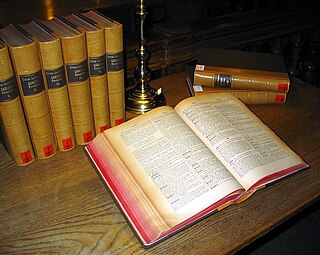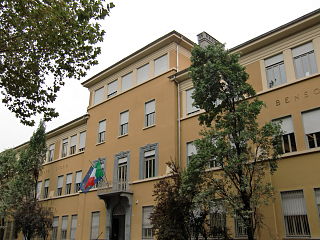
Francesco Scipione Maffei was an Italian writer and art critic, author of many articles and plays. An antiquarian with a humanist education whose publications on Etruscan antiquities stand as incunables of Etruscology, he engaged in running skirmishes in print with his rival in the field of antiquities, Antonio Francesco Gori.

Gymnasium is a term in various European languages for a secondary school that prepares students for higher education at a university. It is comparable to the US English term preparatory high school. Before the 20th century, the gymnasium system was a widespread feature of educational systems throughout many European countries.

Matura or its translated terms is a Latin name for the secondary school exit exam or "maturity diploma" in various European countries centered around the former Austro-Hungarian Empire, including Albania, Austria, Bosnia and Herzegovina, Bulgaria, Croatia, Czech Republic, Hungary, Italy, Kosovo, Liechtenstein, Montenegro, North Macedonia, Poland, Serbia, Slovakia, Slovenia, Switzerland and Ukraine.
The lyceum is a category of educational institution defined within the education system of many countries, mainly in Europe. The definition varies among countries; usually it is a type of secondary school. Basic science and some introduction to specific professions are generally taught.
Khâgne, officially known as classes préparatoires littéraires, is a two-year academic program in the French “post-bac” (≈undergraduate) system, with a specialization in literature and the humanities. It is one of the three main types of Classe préparatoire aux grandes écoles, contrasting with other CPGE majors such as Maths Sup in mathematics and engineering, or Prépa HEC in the business domain.
Literae humaniores, nicknamed classics, is an undergraduate course focused on classics at the University of Oxford and some other universities. The Latin name means literally "more human literature" and was in contrast to the other main field of study when the university began, i.e. res divinae, also known as theology. Lit. hum., is concerned with human learning, and lit. div. with learning treating of God. In its early days, it encompassed mathematics and natural sciences as well. It is an archetypal humanities course.
Voorbereidend wetenschappelijk onderwijs is the highest variant in the secondary educational system of the Netherlands, attended by approximately a fifth of all Dutch high school students. After leaving primary or elementary school students are enrolled in different types of secondary schools, according to their academic ability. The course is a six-year course and successful completion allows the candidate admission to Dutch universities. The VWO is therefore a matriculation exam.

The classes préparatoires aux grandes écoles (CPGE), commonly called classes prépas or prépas, are part of the French post-secondary education system. They consist of two years of study which act as an intensive preparatory course with the main goal of training students for enrolment in one of the grandes écoles. The workload is one of the highest in Europe(29 to 45 contact hours a week, with up to 10 hours of guided tutorials and oral exam sessions).

Liceo scientifico is a type of secondary school in Italy. It is designed to give students the skills to progress to any university or higher educational institution. Students can attend the liceo scientifico after successfully completing middle school.
Selectividad is the popular name given to the Spanish University Admission Tests, a non-compulsory exam taken by students after secondary school, necessary to get into University. Students must take six 90-minute written exams over three days in June or September, consisting of common and specific subjects taken in "Bachillerato". Selectividad exams are set by the Public Universities of each autonomous community and allow students access to the Spanish university system.

Israel Arts and Science Academy (IASA) is an Israeli boarding school for gifted high school students.

The liceo classico or ginnasio is the oldest, public secondary school type in Italy. Its educational curriculum spans over five years, when students are generally about 14 to 19 years of age.

The Latin language is still taught in many parts of the world. In many countries it is offered as an optional subject in some secondary schools and universities, and may be compulsory for students in certain institutions or following certain courses. For those wishing to learn the language independently, there are printed and online resources.
Istituto Messedaglia, officially called "Liceo Scientifico Angelo Messedaglia", is one of the oldest schools in Verona, Veneto, North Italy. It is a scientific school, with students who focus on the scientific subjects and can choose different paths: traditional, PNI or languages.

Liceo Ginnasio statale "Camillo Benso di Cavour" is the oldest Liceo classico in Turin and one among the oldest and most prominent high schools in Italy, for pupils aged 14 to 19. It was transferred to its present location in 1931.
Secondary education in Italy lasts eight years and is divided in two stages: scuola secondaria di primo grado, also known as scuola media, corresponding to the ISCED 2011 Level 2, middle school and scuola secondaria di secondo grado, which corresponds to the ISCED 2011 Level 3, high school. The middle school lasts three years from the age of 11 to age 14, and the upper secondary from 14 to 19.
Liceo linguistico is a type of secondary school in Italy. It is designed to give students the skills to progress to any university or higher educational institution. Students can attend the liceo linguistico after successfully completing middle school.
Liceo Classico “Quinto Orazio Flacco” is the oldest institution for secondary education in the city of Bari, Apulia, Italy. Commonly known as Flacco, this liceo classico welcomes students from 14 to 19 years of age. The scholastic environments are still located in the original building, which was built along a stretch of Bari’s Lungomare in 1933.

Liceo Classico Paolo Sarpi is a prominent public high school in Bergamo, Lombardy, northern Italy, because of the methodology combining Ancient Greek language and culture, Latin language and culture, Scientific studies with Philosophy and History. Every year, some 100 students graduate from Sarpi, that is one of Italy's oldest humanistic, scientific and social high schools. Established in 1506 under the name of Accademia della Misericordia, the academy is named after Venetian polymath Paolo Sarpi since 1803.

Ancient Greek language is still taught in some parts of the world. One of the very few schooling systems where Ancient Greek is still a compulsory subject is Italy. Ancient Greek is usually treated as a written language in formal instruction.











